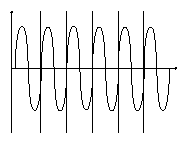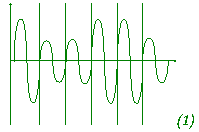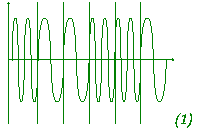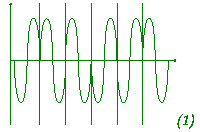| (a) |
What is a modem? It is a device that converts a stream of digital signals into analog signals (and vice versa) (1), using MO dulation and DEM odulation (1).
|
[2] |
| (b) |
The diagram below depicts a sine wave. Explain with the aid of diagrams how the signature of this wave can be modified to carry intelligent information using three modulation techniques.In each case,show how the data stream 100110 might be modulated.
Amplitude modulation (1):the height of the sine wave is varied to transmit the ones and zeros (1).
Frequency modulation (1):the frequency or number of oscillations per cycle is varied to transmit ones and zeros (1).
Phase modulation (1):the phase of the sine wave is shifted (or not)in order to denote a one (or a zero)(1).
Candidates may use different phase shifts in phase modulation;the diagram may not resemble that shown here.
|
[9] |
| (c) |
Explain in detail synchronous and asynchronous transmission. Award marks for these or other points;no more than three under one heading: Synchronous : used for high-speed transmission of a block of data called a packet (1). Established by passing predetermined groups framing bits or SYN characters when the line is idle or prior to transmission (1). These SYN bits are used to adjust the rate of speed at the receiver side (1). Asynchronous: Called start-stop protocol. Each character is transmitted independently of all other characters at random intervals (1). For transmission and timing purposes,a start bit and a stop bit are put on to each end of each character (1). |
[4] |



